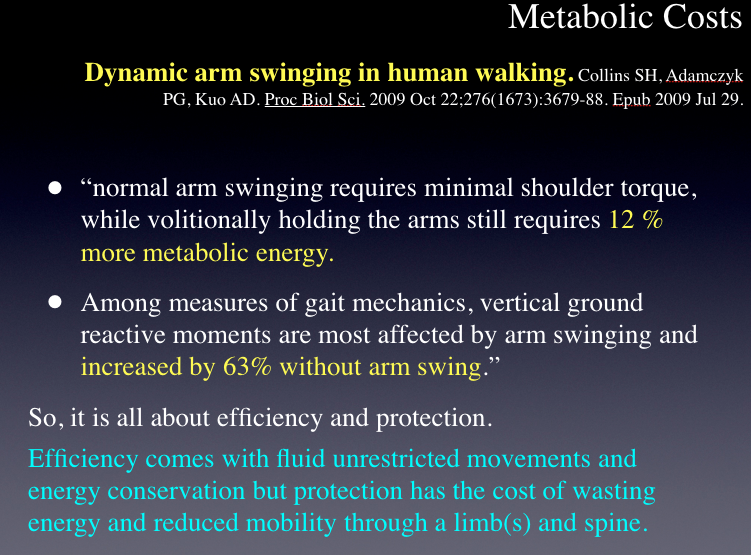The metabolic cost of human running: is swinging the arms worth it?
(precursor: *photo depicts a nice wide antiphasic gait, when that narrows, possibly for spine protection, limb swing becomes more phasic. In these senarios, forcing more arm swing action in a runner is foolish. One is not likely smarter than their client's body's protective mechanisms, so one needs to stop forcing things when they don't know what they are dealing with).
There remains scant info regarding the metabolic benefit of arm swing during human running. We have written about arm swing many times in the past, the concepts of phasic and antiphasic upper and lower limb swing (and their impact on spine loading) are critical for one to understand if they are working with runners. Without the understanding of these principles, coaching runners on form change adds risk to the plate of your client. Feel free to search our blog on these topic. But while you read on, please keep in mind all those strange unilateral compensatory arm swing things you see, such as an abducted arm on one side, a circumducting arm, one arm swinging more than the other, or less than the other, sports where we are carrying something (ie. a football) or throwing (ie javelin), or running with a water bottle. And please consider going back and re-reading all of our arm swing posts discussing why coaching a different arm swing, certainly a corrective arm swing, might be a bad idea because it could be a compensation from the lower limbs since the arms are positioned to be such good postural ballasts.
Here Arellano & Kram "compared the metabolic cost of running using normal arm swing with the metabolic cost of running while restricting the arms in three different ways: (1) holding the hands with the arms behind the back in a relaxed position (BACK), (2) holding the arms across the chest (CHEST) and (3) holding the hands on top of the head (HEAD)."
They hypothesized that "running without arm swing would demand a greater metabolic cost than running with arm swing." What the found in comparing with running using normal arm swing, a net metabolic power demand was 3, 9 and 13% greater for the BACK, CHEST and HEAD conditions, respectively (all P<0.05).
They also discovered that "when running without arm swing, subjects significantly increased the peak-to-peak amplitudes of both shoulder and pelvis rotation about the vertical axis, most likely a compensatory strategy to counterbalance the rotational angular momentum of the swinging legs."
In conclusion, Arellano and Kram's findings "support a general hypothesis that swinging the arms reduces the metabolic cost of human running". Their findings also "demonstrate that arm swing minimizes torso rotation". We infer that actively swinging the arms provides both metabolic and biomechanical benefits during human running. (Our big question is, when said clients come in for an upper quarter limb problem , is it because they may have been coached to actively swing the arms, or swing them differently?). Those who coach arm swing changes without a physical examination to determine why one arm has an aberrant swing may be driving new compensations onto old compensations, which could very well be the source of the problem.
Important: this study likely did not look at the aberrant arm swing habits that develop when there is a lower limb mechanical aberrancy. The literature has suggested that arm swing motor patterns are subservient to the leg swing motor patterns, and so coaching arm swing changes seems a bit foolish if the literature is in fact correct. Also, this study does seem to mention asymmetries in arm swing, and how these, though when different may change metabolic cost, may be necessary because of impairments in the antiphasic relationship of the upper and lower limb action.
J Exp Biol. 2014 Jul 15;217(Pt 14):2456-61. doi: 10.1242/jeb.100420.
The metabolic cost of human running: is swinging the arms worth it? Arellano CJ1, Kram R2.

















